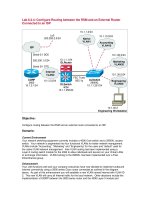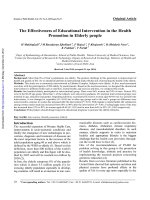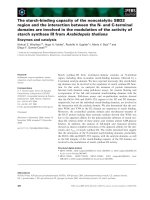FACILITATING DIALOGUE BETWEEN THE HEALTH AND EDUCATION SECTORS TO ADVANCE SCHOOL HEALTH PROMOTION AND EDUCATION pdf
Bạn đang xem bản rút gọn của tài liệu. Xem và tải ngay bản đầy đủ của tài liệu tại đây (983.34 KB, 6 trang )
A document of the International Union for Health Promotion and Education (IUHPE)
Available for download at our web pages on Promoting Health in Schools
Published in August 2012
Lawrence St Leger,
1
Ian Young
2
and Claire Blanchard
3
FACILITATING DIALOGUE BETWEEN THE HEALTH
AND EDUCATION SECTORS TO ADVANCE SCHOOL
HEALTH PROMOTION AND EDUCATION
Schools are primarily places of learning and teaching. For over 100 years, aspects
of health have been included in the curriculum of many countries. Yet the time
allocated to it has always been small. The health content and issues explored
have often been shaped by the health sector reflecting the current health issues
of the country and/or region e.g. hygiene, disease transmission, weight manage-
ment, sexually transmitted diseases (STDs), drugs etc. At the same time the edu-
cation sector has usually attempted to develop an approach to health grounded
in educational parameters e.g. enhancing students’ knowledge and understand-
ing, developing their analytical and evaluative competencies about individual
and community health issues and providing opportunities for them to create
ideas and strategies to address such issues.
There has always been a need for ongoing and constant dialogue between both
health and education to enable school-based initiatives to be relevant to young
people and for the goals of the initiative to have a very high chance of being
achieved.
This document is designed to provide the stakeholders in school health with sim-
ple and practical insights into facilitating and improving dialogue between health
and education.
It does this by
Identifying the current dilemmas
Exploring ‘what are realistic outcomes for school health’, and
Indicating strategies that have a high degree of success.
This document is for policy makers and practitioners in the health and education
sectors and for non-governmental organisations.
1 - Honorary Professor, Deakin University
2 - Health Promoting Schools Consultant, IUHPE. (Formerly Head of International Development NHS Health
Scotland)
3 - Programme Officer, International Union for Health Promotion and Education
1. Different agendas and priorities.
Traditionally the health sector saw schools as a setting where a very important
population group (young people from approximately 5 to 17 years) could be
accessed to provide them with information about health and appropriate
behaviours that would improve and sustain their health status. Consequently the
resources available were/are focused primarily on knowledge. There was/is an
assumption that young people could access this knowledge and make relevant
changes to their behaviours which impacted on their health.
However, scientific evidence about behaviour change and the development of
young people’s bodies and their capacity for processing information has changed
the ways many in the health sector think and act about school health. The Ottawa
Charter for Health Promotion, drafted in 1986, set out a wider concept of health
about school health promotion and offered five key planks of action for promoting
health. This document played a significant role in influencing how the health sector
thinks. The very widely used and accepted framework of the Health Promoting
School (HPS) is an outcome of this. The HPS has six areas where action takes place.
These are:
Healthy school policies
The school’s physical environment
The school’s social environment
Individual health skills and action competencies
Community links
Health services
The dilemmas
1
Different agendas
and priorities
2
Time
3
Different models
4
Different cultural,
social and political
systems and
resources
The dilemmas
At the same time the education sector had been developing its own sophisticated view of learning and
teaching. For example a large body of evidence about how young people learn, curriculum theories and
models, teaching approaches and styles, school leadership and management, have all shaped how the
education sector thinks and acts about the purposes of school education. The competencies schools aim for,
seek to empower young people with abilities to enter the adult world and also to have skills about, and
insight into their own learning needs. Health education in schools has changed significantly in the last 20
years. Its outcomes are nearly always based on ensuring students have high levels of cognitive skills in the
following areas:
Remembering
Understanding
Applying
Analysing
Evaluating
Creating
Rarely does education seek to measure its health initiatives by assessing health outcomes such as biometrics
related to obesity, levels of disease transmission or the prevalence of substance use/misuse.
Meanwhile the health sector, not surprisingly sees its role to reduce levels of morbidity and mortality in the
community and to access the 5 to 17 year old population group with interventions (a term alien to the
education system). These interventions would often be based on information transfer to achieve these goals.
The HPS framework has encouraged close collaboration between health and education but there is still
misunderstanding between the sectors on the language, concepts and purposes of school health. Is the goal
improved health behaviours to reduce morbidity and mortality or an increased set of cognitive attributes
that are fundamental to being empowered throughout life?
2. Time
Teaching about literacy and numeracy, involves many learning experiences over all the years of schooling.
The time allocated to these areas and others such as science, historical and social studies, culture and the
arts etc., is always in excess of the time available for health. Simply, there is very little time in the curriculum
to achieve many of the educational goals of health education, let alone the wishes of the health sector for
the adoption of practices conducive to better health. In addition, health is one of several subject areas or
sectors, which believe that they are under-represented in the basic school curriculum. It is unlikely this ‘time
poor’ dilemma for school health will change in the foreseeable future.
3. Different models
Public health achieved considerable health improvements in the 19
th
Century with for
example, treatment and legislation relating to water supply, sewage disposal and safer food. In
the last century this legacy was extended with improvements in nutrition, the introduction of
antibiotics and the sulphonamide drugs, early childhood vaccinations, the introduction of
legislation on the compulsory use of seat belt and tobacco controls and taxation etc. While
many countries retain a school health service, in other countries a public health intervention
approach is not deemed appropriate or relevant for schools, except as a site for mass
vaccinations of children as appropriate.
The primary role of education in schools is learning and the social development of young
people. Schools focus mainly on building a body of knowledge and competencies in all areas of
the curriculum. Their task is not to solve the problems of society, including public health
issues, but ideally to take a positive approach to nurturing, encouraging and challenging
children and adolescents in ways that are appropriate to their age and levels of psychological
development across a range of curriculum areas.
4. Different cultural, social and political systems and resources
The Ottawa Charter for Health Promotion and many of its subsequent charters and declarations e.g. The
Bangkok Declaration, talk about equity, social justice, democratic rights, individual rights etc. However, not
all countries uphold these principles and beliefs. Sadly, in many parts of the world, young people are overtly
denied opportunities for education that may be influenced by poverty, civil unrest, beliefs about the roles of
males and females and other social determinants of health. There are also less overt roles of education
systems. Schools are vulnerable to distortion of the curriculum content and methods for extreme political or
other ends. As a consequence of all of this, the curriculum of schools is a product of the history, culture,
political climate, economic pressures and social judgements of a society or country.
One of the international challenges is to actually create an infrastructure in many countries that constructs
schools and equips them with trained teachers so children can experience a basic education. The UN
millennium development goals reflect this and great progress is being made on access to a universal basic
education. However it is a modest goal that, for example, doesn’t necessarily apply to teenagers. It
therefore follows that school health promotion and education is a very low priority in many parts of the
world, where the important issues of basic literacy have not been solved and young women are denied
access to educational opportunities. Although an irony of these higher priorities, is that the evidence is
unequivocal that better literacy for young women would also have a huge impact on the public health of
such countries.
Evidence from the large amount of research from both the education and health fields and from the many
evaluative studies of school health programs and practices, has provided us with a solid information base
about what we can collaboratively in School Health. The IUHPE has produced two documents, which are
strongly evidence based, and which have been reviewed by researchers and practitioners. They are:
What is realistic?
Achieving Health Promoting
Schools: Guidelines for
promoting health in schools
(available in 9 languages)
Promoting Health in School:
from evidence to action
(available in 9 languages)
The two documents summarise succinctly the evidence and provide clear guidelines to
support effective school health initiatives. They also identify what the research tells us about
the conditions for success.
In summary, it is possible to address the intentions of both the health and education sectors
providing health and education work together and if the expectations of the school based
initiatives are realistic, well resourced and take place over a considerable time, at least 5 to 7
years.
Evaluation of many collaborations between health and education have identified a number
of key components for successful dialogue between the two sectors that contributes to
effective school health promotion and education.
a. Developing and maintaining partnerships and commitment between health and education
policy makers
This is essential. It is important that it be at the highest level of the jurisdictions in the first instance
and that there be continuous and active commitment and support to the ongoing implementation,
renewal, monitoring and evaluation of the program initiatives. A signed partnership document
between senior personnel from health and education ministries has been an effective way of
formalizing this commitment. In some countries this partnership has even been formalized in
legislation with for example nutritional standards being set up for school food and a requirement
being set out for education inspectors to monitor this health issue.
b. Providing resources that complement the fundamental role of the teacher and which are of a
sound factual and theoretical base
Resources for students complement the learning strategy, which is shaped and guided by teachers.
Developing such resources requires on-going dialogue between health agencies and those with
knowledge and experience in curriculum design and implementation and learning styles.
c. Ensuring that funding supports a health promotion approach and is not focused mainly
on morbidity and mortality reduction
Evidence strongly supports a focus on health promotion and addressing all six areas of the
Health Promoting School. All six areas need to be part of school health planning. Evidence
suggests both health and education outcomes are enhanced if this holistic strategy is used.
d. Having a shared understanding of concepts and language
The education sector has certain language and concepts that have different meanings to
those in health and other sectors and vice versa. Evidence has shown that understanding,
time, and mutual respect are necessary to sustain successful partnerships. It also shows
that regular contacts between members of joint working parties/committees plus
continuity of membership are essential for success.
Components of Successful Dialogue and Collaboration
What is realistic?
It is possible to address the
intentions of both the
health and education
sectors providing health
and education work
together and if the
expectations of the school
based initiatives are
realistic, well resourced
and take place over a
considerable time, at least
5 to 7 years.
e. The necessity to provide the education sector with evidence about the advantages a health
promoting strategy can offer schools in improving educational outcomes
Schools are becoming more accountable to their communities e.g. parents and their School
Board/Council and their own education ministry. Their prime focus is to maximise educational
outcomes. It is essential that dialogue between health and education addresses how the
health initiative contributes to the school achieving its education and social goals.
f. Valuing partnership working and reflecting this in staff development and promotion
structures
If the education and health sectors really value partnerships then this will be reflected in the
training and promotion opportunities for staff in both sectors. For example the funding of
joint posts between the sectors and ensuring this is a career choice for a professional that
could lead to further valued work in either or both sectors.
g. Focusing on the area of Social and Emotional Wellbeing as the most important and
influential health issue/topic
Evidence from many studies shows that this area of health is the fundamental building block for
young people. Social and emotional health and wellbeing need to be at the centre of a collaborative
dialogue as the two sectors react to what is appropriate for schools on addressing issues such as
drugs, body image, sexuality. Such a dialogue will reveal the extent to which apparently different
topics are united when an educational and psychosocial perspective is taken. Social and emotional
factors are pivotal to the way young people learn and to the way Health Promoting Schools operate.
Taking this approach can help schools achieve their health and education goals without the
curriculum being overloaded with new topics.
ACKNOWLEDGEMENTS
This initiative is supported by the International Union for Health Promotion and Education
(IUHPE) and the US Centers for Disease Control and Prevention (CDC).
Disclaimer: The production of this document has received financial support from the United States Centers for Disease Control and
Prevention (CDC), an Agency of the Department of Health and Human Services, under Cooperative Agreement Number CDC RFA DP07-708 on
Building Capacity of Developing Countries to Prevent non-Communicable Diseases. The content of this publication is solely the responsibility
of the authors and do not necessarily represent the official views of CDC.









